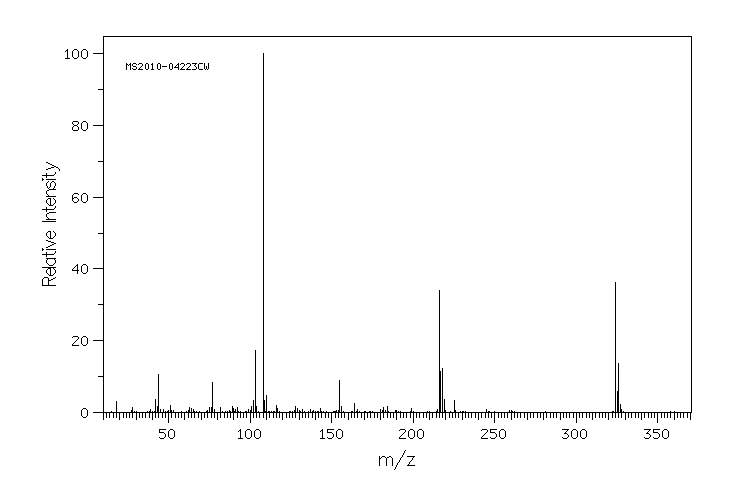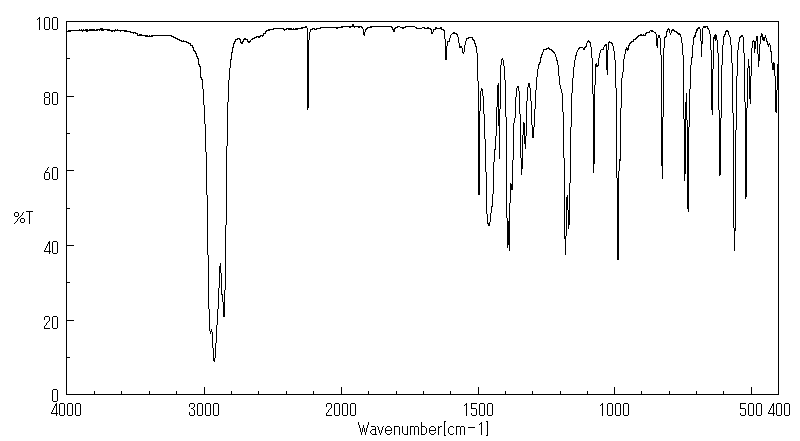氰霜唑 | 120116-88-3
-
物化性质
-
计算性质
-
ADMET
-
安全信息
-
SDS
-
制备方法与用途
-
上下游信息
-
文献信息
-
表征谱图
-
同类化合物
-
相关功能分类
-
相关结构分类
物化性质
-
熔点:152.7°
-
沸点:498.2±37.0 °C(Predicted)
-
密度:1.38±0.1 g/cm3(Predicted)
-
闪点:4 °C
-
溶解度:DMF:15mg/mL;二甲基亚砜:10mg/mL
-
LogP:1.750 (est)
-
颜色/状态:Ivory powder
-
气味:Odorless
-
蒸汽压力:1.3X10-2 mPa /9.75X10-8 mm Hg/ at 35 °C
-
解离常数:No pKa evident in pH range 2-12
-
碰撞截面:166.69 Ų [M+H]+ [CCS Type: TW]
-
保留指数:2388
计算性质
-
辛醇/水分配系数(LogP):2.6
-
重原子数:21
-
可旋转键数:3
-
环数:2.0
-
sp3杂化的碳原子比例:0.23
-
拓扑面积:87.4
-
氢给体数:0
-
氢受体数:5
ADMET
安全信息
-
危险品标志:Xn,F
-
安全说明:S36/37
-
危险类别码:R11
-
WGK Germany:3
-
危险品运输编号:UN1294 3/PG 2
SDS
: 氰霜唑
产品名称
1.2 鉴别的其他方法
无数据资料
1.3 有关的确定了的物质或混合物的用途和建议不适合的用途
仅供科研用途,不作为药物、家庭备用药或其它用途。
模块 2. 危险性概述
2.1 GHS分类
急性毒性, 经口 (类别4)
急性毒性, 吸入 (类别4)
急性毒性, 经皮 (类别4)
2.2 GHS 标记要素,包括预防性的陈述
象形图
警示词 警告
危险申明
H302 吞咽有害。
H312 皮肤接触有害。
H332 吸入有害。
警告申明
预防
P261 避免吸入粉尘/烟/气体/烟雾/蒸气/喷雾.
P264 操作后彻底清洁皮肤。
P270 使用本产品时不要进食、饮水或吸烟。
P271 只能在室外或通风良好之处使用。
P280 穿戴防护手套/ 防护服。
措施
P301 + P312 如果吞下去了: 如感觉不适,呼救解毒中心或看医生。
P302 + P352 如与皮肤接触,用大量肥皂和水冲洗受感染部位.
P304 + P340 如吸入,将患者移至新鲜空气处并保持呼吸顺畅的姿势休息.
P312 如感觉不适,呼救中毒控制中心或医生.
P322 具体措施(见本标签上提供的急救指导)。
P330 漱口。
P363 沾染的衣服清洗后方可重新使用。
处理
P501 将内容物/ 容器处理到得到批准的废物处理厂。
当心 - 物质尚未完全测试。
2.3 其它危害物 - 无
模块 3. 成分/组成信息
3.1 物 质
: C13H13ClN4O2S
分子式
: 324.79 g/mol
分子量
组分 浓度或浓度范围
1H-Imidazole-1-sulfonamide, 4-chloro-2-cyano-N,N-dimethyl-5-(4-methylphenyl)-
-
CAS 号 120116-88-3
模块 4. 急救措施
4.1 必要的急救措施描述
一般的建议
请教医生。 出示此安全技术说明书给到现场的医生看。
吸入
如果吸入,请将患者移到新鲜空气处。 如果停止了呼吸,给于人工呼吸。 请教医生。
皮肤接触
用肥皂和大量的水冲洗。 请教医生。
眼睛接触
用水冲洗眼睛作为预防措施。
食入
切勿给失去知觉者从嘴里喂食任何东西。 用水漱口。 请教医生。
4.2 主要症状和影响,急性和迟发效应
据我们所知,此化学,物理和毒性性质尚未经完整的研究。
4.3 及时的医疗处理和所需的特殊处理的说明和指示
无数据资料
模块 5. 消防措施
5.1 灭火介质
灭火方法及灭火剂
用水雾,耐醇泡沫,干粉或二氧化碳灭火。
5.2 源于此物质或混合物的特别的危害
碳氧化物, 氮氧化物, 硫氧化物, 氯化氢气体
5.3 给消防员的建议
如必要的话,戴自给式呼吸器去救火。
5.4 进一步信息
无数据资料
模块 6. 泄露应急处理
6.1 人员的预防,防护设备和紧急处理程序
使用个人防护设备。 防止粉尘的生成。 防止吸入蒸汽、气雾或气体。 保证充分的通风。 避免吸入粉尘。
6.2 环境保护措施
不要让产物进入下水道。
6.3 抑制和清除溢出物的方法和材料
收集、处理泄漏物,不要产生灰尘。 扫掉和铲掉。 存放进适当的闭口容器中待处理。
6.4 参考其他部分
丢弃处理请参阅第13节。
模块 7. 操作处置与储存
7.1 安全操作的注意事项
避免接触皮肤和眼睛。 防止粉尘和气溶胶生成。
在有粉尘生成的地方,提供合适的排风设备。
7.2 安全储存的条件,包括任何不兼容性
贮存在阴凉处。 容器保持紧闭,储存在干燥通风处。
建议的贮存温度: -20 °C
7.3 特定用途
无数据资料
模块 8. 接触控制和个体防护
8.1 容许浓度
最高容许浓度
没有已知的国家规定的暴露极限。
8.2 暴露控制
适当的技术控制
按照良好工业和安全规范操作。 休息前和工作结束时洗手。
个体防护设备
眼/面保护
带有防护边罩的安全眼镜符合 EN166要求请使用经官方标准如NIOSH (美国) 或 EN 166(欧盟)
检测与批准的设备防护眼部。
皮肤保护
戴手套取 手套在使用前必须受检查。
请使用合适的方法脱除手套(不要接触手套外部表面),避免任何皮肤部位接触此产品.
使用后请将被污染过的手套根据相关法律法规和有效的实验室规章程序谨慎处理. 请清洗并吹干双手
所选择的保护手套必须符合EU的89/686/EEC规定和从它衍生出来的EN 376标准。
身体保护
全套防化学试剂工作服, 防护设备的类型必须根据特定工作场所中的危险物的浓度和含量来选择。
呼吸系统防护
如须暴露于有害环境中,请使用P95型(美国)或P1型(欧盟 英国
143)防微粒呼吸器。如需更高级别防护,请使用OV/AG/P99型(美国)或ABEK-P2型 (欧盟 英国 143)
防毒罐。
呼吸器使用经过测试并通过政府标准如NIOSH(US)或CEN(EU)的呼吸器和零件。
模块 9. 理化特性
9.1 基本的理化特性的信息
a) 外观与性状
形状: 固体
b) 气味
无数据资料
c) 气味阈值
无数据资料
d) pH值
无数据资料
e) 熔点/凝固点
无数据资料
f) 起始沸点和沸程
无数据资料
g) 闪点
无数据资料
h) 蒸发速率
无数据资料
i) 易燃性(固体,气体)
无数据资料
j) 高的/低的燃烧性或爆炸性限度 无数据资料
k) 蒸汽压
无数据资料
l) 蒸汽密度
无数据资料
m) 相对密度
无数据资料
n) 水溶性
无数据资料
o) n-辛醇/水分配系数
无数据资料
p) 自燃温度
无数据资料
q) 分解温度
无数据资料
r) 粘度
无数据资料
模块 10. 稳定性和反应活性
10.1 反应性
无数据资料
10.2 稳定性
无数据资料
10.3 危险反应的可能性
无数据资料
10.4 应避免的条件
无数据资料
10.5 不兼容的材料
无数据资料
10.6 危险的分解产物
其它分解产物 - 无数据资料
模块 11. 毒理学资料
11.1 毒理学影响的信息
急性毒性
无数据资料
皮肤刺激或腐蚀
无数据资料
眼睛刺激或腐蚀
无数据资料
呼吸道或皮肤过敏
无数据资料
生殖细胞突变性
无数据资料
致癌性
IARC:
此产品中没有大于或等于 0。1%含量的组分被 IARC鉴别为可能的或肯定的人类致癌物。
生殖毒性
无数据资料
特异性靶器官系统毒性(一次接触)
无数据资料
特异性靶器官系统毒性(反复接触)
无数据资料
吸入危险
无数据资料
潜在的健康影响
吸入 吸入有害。 可能引起呼吸道刺激。
摄入 误吞对人体有害。
皮肤 如果通过皮肤被吸收是有害的。 可能引起皮肤刺激。
眼睛 可能引起眼睛刺激。
接触后的征兆和症状
据我们所知,此化学,物理和毒性性质尚未经完整的研究。
附加说明
化学物质毒性作用登记: 无数据资料
模块 12. 生态学资料
12.1 生态毒性
无数据资料
12.2 持久存留性和降解性
无数据资料
12.3 潜在的生物蓄积性
无数据资料
12.4 土壤中的迁移性
无数据资料
12.5 PBT 和 vPvB的结果评价
无数据资料
12.6 其它不利的影响
无数据资料
模块 13. 废弃处置
13.1 废物处理方法
产品
将剩余的和未回收的溶液交给处理公司。
与易燃溶剂相溶或者相混合,在备有燃烧后处理和洗刷作用的化学焚化炉中燃烧
受污染的容器和包装
作为未用过的产品弃置。
模块 14. 运输信息
14.1 联合国危险货物编号
欧洲陆运危规: 3077 国际海运危规: 3077 国际空运危规: 3077
14.2 联合国(UN)规定的名称
欧洲陆运危规: ENVIRONMENTALLY HAZARDOUS SUBSTANCE, SOLID, N.O.S. (1H-Imidazole-1-
sulfonamide, 4-chloro-2-cyano-N,N-dimethyl-5-(4-methylphenyl)-)
国际海运危规: ENVIRONMENTALLY HAZARDOUS SUBSTANCE, SOLID, N.O.S. (1H-Imidazole-1-
sulfonamide, 4-chloro-2-cyano-N,N-dimethyl-5-(4-methylphenyl)-)
国际空运危规: EnvironmeNTAlly hazardous subSTance, solid, n.o.s. (1H-Imidazole-1-sulfonamide, 4-chloro-
2-cyano-N,N-dimethyl-5-(4-methylphenyl)-)
14.3 运输危险类别
欧洲陆运危规: 9 国际海运危规: 9 国际空运危规: 9
14.4 包裹组
欧洲陆运危规: III 国际海运危规: III 国际空运危规: III
14.5 环境危险
欧洲陆运危规: 是 国际海运危规 海运污染物: 是 国际空运危规: 是
14.6 对使用者的特别提醒
进一步信息
危险品独立包装,液体5升以上或固体5公斤以上,每个独立包装外和独立内包装合并后的外包装上都必须有EHS
标识 (根据欧洲 ADR 法规 2.2.9.1.10, IMDG 法规 2.10.3),
模块 15 - 法规信息
N/A
模块16 - 其他信息
N/A
制备方法与用途
毒性 大鼠急性经口LD₅₀ >5000mg/kg,急性经皮LD₅₀ >5000mg/kg,急性吸入LD₅₀ >2000mg/kg。对大鼠眼睛刺激LC₅₀ >5.5mg/L;对兔皮肤有轻微刺激,皮肤过敏性有极轻微刺激;豚鼠无致敏作用,无致癌、致畸或致突变作用。在水生生物方面,鲤鱼LC₅₀ >69.6mg/L (48h),虹鳟鱼LC₅₀ >100mg/L(48h),水蚤EC₅₀ >0.487mg/L (3h),月牙藻EₐC₅₀ >0.858mg/L (72h)。鹌鹑急性LD₅₀ >2000mg/kg,饲料LC₅₀ >5000mg/kg;鸭子急性LD₅₀ >2000mg/kg,饲料LC₅₀ >5000mg/kg;蜜蜂经口LD₅₀ >151.7μg/只,接触LD₅₀ >100μg/只;蚯蚓急性NDEC >1000mg/kg。
作用机理 氰霜唑是一种线粒体呼吸抑制剂。它和strobilurin类杀菌剂一样都是在线粒体呼吸链中的复合体Ⅲ(泛醌细胞色素c还原酶),但它们分别抑制了细胞色素bcl上的Qi位点,和细胞色素bc₁上的Qo位点。由于生化酶敏感性的不同产生选择性。它可用于叶面和土壤保护性杀菌剂,具有一定的传导性和治疗作用,对卵菌的所有生长阶段均有活性,并且对甲霜灵产生抗性或敏感的病菌都有活性。
化学性质 氰霜唑是一种浅黄色无味的粉状固体,熔点为152.7℃。其蒸汽压 < 1.33×10⁻⁵Pa,在20℃时水中的溶解度为0.121 μg/mL (pH=5),分配系数为3.2 (25℃)。
用途 氰霜唑属于磺胺咪唑类杀菌剂。对卵菌纲真菌,如疫霉菌、霜霉菌、假霜霉菌和腐霉菌以及根肿菌纲的芸苔根肿菌具有很高的生物活性。作用机制是阻断卵菌纲病菌体内线粒体细胞色素bc₁复合体的电子传递来干扰能量供应,其结合部位为酶的Q₁中心,并与其他杀菌剂无交叉抗性。其对病原菌的选择性活性可能是由于靶标酶对药剂敏感程度的不同造成的。田间应用对晚疫病和霜霉病有极高的防治效果,使用剂量比其他杀菌剂低2~38倍,如以50~100mg/L的浓度处理马铃薯晚疫病时表现出突出的防治效果,并且用药期灵活、持效期长。同样浓度用于葡萄、黄瓜和甜瓜的霜霉病防治也表现出极好的效果。该药剂可延长作物生长期并增加产量,适用于番茄提高品质。使用次数不超过4次,使用方法为叶面喷雾。在高出实际用量4倍的处理浓度下,未见药害报道。目前正扩大防治对象,包括甜椒疫病、西瓜绵腐病、大白菜霜霉病、洋葱霜霉病及其他病害。
生产方法 以4-甲基苯乙酮为原料,先经氯化反应,再与羟胺缩合,然后与乙二醛环合成中间体取代的咪唑;之后通过氯化脱水制备中间体取代的氰基咪唑,最后与二甲氨基磺酰氯进行反应以生成氰霜唑。
反应信息
-
作为产物:描述:参考文献:名称:一种4-氯-2-氰基-N,N-二甲基-5-(4’-甲基苯 基)-1H-咪唑-1-磺酰胺的合成方法摘要:本发明公开了一种4-氯-2-氰基-N,N-二甲基-5-(4’-甲基苯基)-1H-咪唑-1-磺酰胺(氰霜唑)的合成方法,该方法以对甲基苯乙酮为原料,用二氧化硒氧化制备中间体2-羰基-2-对苯甲基乙醛,然后采用N,N-二甲基甲酰胺等作溶剂,二氯亚砜作氯化剂及还原剂来制备中间体,此中间体再与N,N-二甲基磺酰胺氯反应合成氰霜唑。本发明与现有技术相比,缩短了反应周期、简化了后处理工艺,适合批量工业化生产。公开号:CN103936678B
文献信息
-
[EN] ACC INHIBITORS AND USES THEREOF<br/>[FR] INHIBITEURS DE L'ACC ET UTILISATIONS ASSOCIÉES
-
[EN] BICYCLYL-SUBSTITUTED ISOTHIAZOLINE COMPOUNDS<br/>[FR] COMPOSÉS ISOTHIAZOLINE SUBSTITUÉS PAR UN BICYCLYLE申请人:BASF SE公开号:WO2014206910A1公开(公告)日:2014-12-31The present invention relates to bicyclyl-substituted isothiazoline compounds of formula (I) wherein the variables are as defined in the claims and description. The compounds are useful for combating or controlling invertebrate pests, in particular arthropod pests and nematodes. The invention also relates to a method for controlling invertebrate pests by using these compounds and to plant propagation material and to an agricultural and a veterinary composition comprising said compounds.本发明涉及公式(I)中变量如索权和说明中所定义的自行车基取代异噻唑啉化合物。这些化合物对抗或控制无脊椎动物害虫,特别是节肢动物害虫和线虫方面具有用途。该发明还涉及一种通过使用这些化合物来控制无脊椎动物害虫的方法,以及包含所述化合物的植物繁殖材料、农业和兽医组合物。
-
[EN] AZOLINE COMPOUNDS<br/>[FR] COMPOSÉS AZOLINE申请人:BASF SE公开号:WO2015128358A1公开(公告)日:2015-09-03The present invention relates to azoline compounds of formula (I) wherein A, B1, B2, B3, G1, G2, X1, R1, R3a, R3b, Rg1 and Rg2 are as defined in the claims and the description. The compounds are useful for combating or controlling invertebrate pests, in particular arthropod pests and nematodes. The invention also relates to a method for controlling invertebrate pests by using these compounds and to plant propagation material and to an agricultural and a veterinary composition comprising said compounds.本发明涉及式(I)的噁唑啉化合物,其中A、B1、B2、B3、G1、G2、X1、R1、R3a、R3b、Rg1和Rg2如权利要求和描述中所定义。这些化合物对抗或控制无脊椎动物害虫,特别是节肢动物害虫和线虫方面具有用途。该发明还涉及一种利用这些化合物控制无脊椎动物害虫的方法,以及包括所述化合物的植物繁殖材料、农业和兽医组合物。
-
[EN] SUBSTITUTED QUINAZOLINES AS FUNGICIDES<br/>[FR] QUINAZOLINES SUBSTITUÉES, UTILISÉES EN TANT QUE FONGICIDES申请人:SYNGENTA PARTICIPATIONS AG公开号:WO2010136475A1公开(公告)日:2010-12-02The present invention relates to a compound of formula (I) wherein wherein the substituents have the definitions as defined in claim 1or a salt or a N-oxide thereof, their use and methods for the control and/or prevention of microbial infection, particularly fungal infection, in plants and to processes for the preparation of these compounds.本发明涉及一种具有如下式(I)的化合物,其中取代基具有权利要求1中定义的定义,或其盐或N-氧化物,它们的用途以及用于控制和/或预防植物中微生物感染,特别是真菌感染的方法,以及制备这些化合物的方法。
-
[EN] MICROBIOCIDAL OXADIAZOLE DERIVATIVES<br/>[FR] DÉRIVÉS D'OXADIAZOLE MICROBIOCIDES申请人:SYNGENTA PARTICIPATIONS AG公开号:WO2017157962A1公开(公告)日:2017-09-21Compounds of the formula (I) wherein the substituents are as defined in claim 1, useful as a pesticides, especially fungicides.式(I)的化合物,其中取代基如权利要求1所定义,作为杀虫剂特别是杀菌剂有用。
表征谱图
-
氢谱1HNMR
-
质谱MS
-
碳谱13CNMR
-
红外IR
-
拉曼Raman
-
峰位数据
-
峰位匹配
-
表征信息








